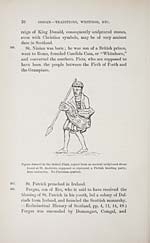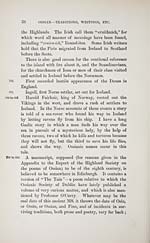Download files
Complete book:
Individual page:
Thumbnail gallery: Grid view | List view

OSSIAN — TRADITIONS, WRITINGS, ETC. 37
Conal, by whom the Island of Iona was bestowed upon
St. Columba. The saint is supposed to have been born
in Donegal, a.d. 521.
St. Columba landed at Iona, and shortly afterwards
preached to the northern Picts. There are conse-
quently good reasons why the traditions of Argyle
should still resemble Irish traditions, and Conal and
Patrick ought to be conspicuous names in West High-
land tales, and Picts ought to appear.
The only Gaelic traditional reference to a people with
a name like that of " the Picts " is an occasional, but
Aery rare, mention of PlOCAlCH, as a kind of men. The
word, pronounced Pyuchk-akh, is common all over the
west, but it means a cole-fish at a particular stage of its
growth. Other sizes of the same fish are called Cud-
AINN, which, as " cuddy," is immortalized by Johnson
as caught by Boswell. A larger size is Ceit-ean-ach,
derived from Ce, the world, tein, fi.re=ceit-ean (part of
April), the spring, directly after which came the festival
of Beal-tainn and its symbolical fires. So "Ceit-ean-
ach" means a "spring-fish," and something very like
the fish meant is sculptured on a Pictish stone in Scot-
land (see vol. iii., page 356, left hand, upper corner),
and these stones date from Pagan times, and probably
have to do with Pagan observances.
The same fish, when grown very large, is called
" ugsa," pr. oox-e, which is the Norse for a bull, and
the whole tribe is called glas-iasg, grey or green fish.
As every clan has some fish, beast, bird, and plant for
a badge, perhaps the Picts adopted this fish, or fish in
general, as their badge, and thus the modern name of
the fish may be the ancient name of a tribe. At all
events, there are plenty of Lowland traditions about
Picts as a different race, but there are scarcely any in
Conal, by whom the Island of Iona was bestowed upon
St. Columba. The saint is supposed to have been born
in Donegal, a.d. 521.
St. Columba landed at Iona, and shortly afterwards
preached to the northern Picts. There are conse-
quently good reasons why the traditions of Argyle
should still resemble Irish traditions, and Conal and
Patrick ought to be conspicuous names in West High-
land tales, and Picts ought to appear.
The only Gaelic traditional reference to a people with
a name like that of " the Picts " is an occasional, but
Aery rare, mention of PlOCAlCH, as a kind of men. The
word, pronounced Pyuchk-akh, is common all over the
west, but it means a cole-fish at a particular stage of its
growth. Other sizes of the same fish are called Cud-
AINN, which, as " cuddy," is immortalized by Johnson
as caught by Boswell. A larger size is Ceit-ean-ach,
derived from Ce, the world, tein, fi.re=ceit-ean (part of
April), the spring, directly after which came the festival
of Beal-tainn and its symbolical fires. So "Ceit-ean-
ach" means a "spring-fish," and something very like
the fish meant is sculptured on a Pictish stone in Scot-
land (see vol. iii., page 356, left hand, upper corner),
and these stones date from Pagan times, and probably
have to do with Pagan observances.
The same fish, when grown very large, is called
" ugsa," pr. oox-e, which is the Norse for a bull, and
the whole tribe is called glas-iasg, grey or green fish.
As every clan has some fish, beast, bird, and plant for
a badge, perhaps the Picts adopted this fish, or fish in
general, as their badge, and thus the modern name of
the fish may be the ancient name of a tribe. At all
events, there are plenty of Lowland traditions about
Picts as a different race, but there are scarcely any in
Set display mode to: Large image | Transcription
Images and transcriptions on this page, including medium image downloads, may be used under the Creative Commons Attribution 4.0 International Licence unless otherwise stated. ![]()
| Early Gaelic Book Collections > Matheson Collection > Popular tales of the west Highlands > Volume 4 > (53) |
|---|
| Permanent URL | https://digital.nls.uk/81487693 |
|---|
| Description | Volume IV. |
|---|---|
| Shelfmark | Mat.77 |
| Additional NLS resources: | |
| Attribution and copyright: |
|
| Description | Items from a collection of 170 volumes relating to Gaelic matters. Mainly philological works in the Celtic and some non-Celtic languages. Some books extensively annotated by Angus Matheson, the first Professor of Celtic at Glasgow University. |
|---|
| Description | Selected items from five 'Special and Named Printed Collections'. Includes books in Gaelic and other Celtic languages, works about the Gaels, their languages, literature, culture and history. |
|---|

